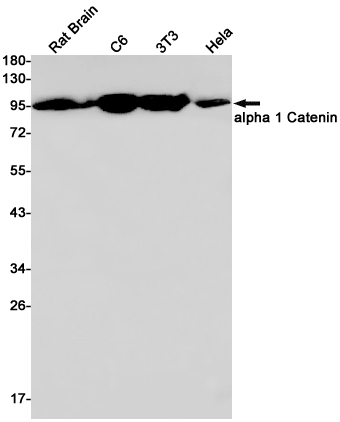-
Product Name
Anti-CTNNA1 Rabbit antibody
- Documents
-
Description
CTNNA1 Rabbit polyclonal antibody
-
Tested applications
WB, IHC-P, ICC/IF, FC, IP
-
Species reactivity
Human, Mouse, Rat
-
Alternative names
MDPT2; CAP102 antibody
-
Isotype
Rabbit IgG
-
Preparation
Antigen: A synthetic peptide of human alpha 1 Catenin
-
Clonality
Polyclonal
-
Formulation
Supplied in 50nM Tris-Glycine(pH 7.4), 0.15M Nacl, 40%Glycerol, 0.01% sodium azide and 0.05% BSA.
-
Storage instructions
Store at -20°C. Stable for 12 months from date of receipt.
-
Applications
WB: 1/5000
IHC: 1/20
ICC/IF: 1/50
FC: 1/20
IP: 1/20
-
Validations

Western blot detection of alpha 1 Catenin in Rat Brain,C6,3T3,Hela cell lysates using alpha 1 Catenin Rabbit pAb(1:1000 diluted).Predicted band size:100kDa.Observed band size:100kDa.
-
Background
Swiss-Prot Acc.P35221.Associates with the cytoplasmic domain of a variety of cadherins. The association of catenins to cadherins produces a complex which is linked to the actin filament network, and which seems to be of primary importance for cadherins cell-adhesion properties. Can associate with both E- and N-cadherins. Originally believed to be a stable component of E-cadherin/catenin adhesion complexes and to mediate the linkage of cadherins to the actin cytoskeleton at adherens junctions. In contrast, cortical actin was found to be much more dynamic than E-cadherin/catenin complexes and CTNNA1 was shown not to bind to F-actin when assembled in the complex suggesting a different linkage between actin and adherens junctions components. The homodimeric form may regulate actin filament assembly and inhibit actin branching by competing with the Arp2/3 complex for binding to actin filaments. May play a crucial role in cell differentiation.
Related Products / Services
Please note: All products are "FOR RESEARCH USE ONLY AND ARE NOT INTENDED FOR DIAGNOSTIC OR THERAPEUTIC USE"
